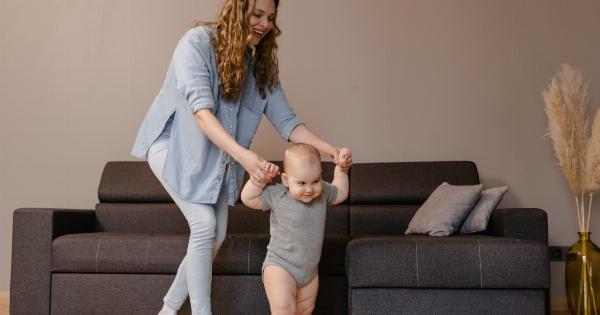Welcoming a newborn into your home is an exciting and joyous experience for parents. However, the new addition to the family also brings along sleepless nights and an adjustment period for both baby and parents.
To ensure the best sleep for your little one, many parents may consider room-sharing, a practice where the newborn sleeps in the same room as the parents.
The Benefits of Room-Sharing
The American Academy of Pediatrics (AAP) recommends room-sharing as an effective way to optimize infant sleep while minimizing the risk of Sudden Infant Death Syndrome (SIDS).
According to a policy statement released by the AAP, infants should sleep in the same room as their parents for at least the first six months, and ideally for the first year of life.
There are several advantages to room-sharing that contribute to improved newborn sleep:.
1. Reduced Risk of SIDS
One of the most significant benefits of room-sharing is the decreased risk of SIDS. According to the AAP, sharing a room, but not a bed, with parents can potentially reduce the risk of SIDS by up to 50%.
Having your baby close by allows you to monitor their breathing and provides easier access for night-time feedings or comfort.
2. Enhanced Parent-Infant Bonding
Room-sharing promotes strong parent-infant bonding. The proximity allows parents to respond more promptly to their baby’s needs, fostering a sense of security and trust in the child.
Research has shown that increased parent-infant bonding can have long-term positive effects on the child’s social and emotional development.
3. Easier Night-Time Feedings
Having your baby sleep in the same room simplifies night-time feedings. Instead of walking to a separate nursery, you can nurse or bottle-feed your baby without leaving the comfort of your bed.
By minimizing disruptions, both parents and babies can return to sleep more quickly after feedings, ensuring everyone gets the rest they need.
4. Ease of Monitoring
Room-sharing allows parents to easily monitor their baby throughout the night. As newborns are vulnerable and may experience breathing irregularities, being in close proximity allows parents to quickly respond and provide necessary care.
This constant vigilance ensures the safety and well-being of the infant.
Creating a Safe Sleep Environment
While room-sharing provides numerous benefits, it is crucial to create a safe sleep environment for your newborn. Follow these guidelines to ensure a secure setup:.
1. Selecting a Crib or Bassinet
Choose a crib or bassinet that meets safety standards. Look for certifications such as Juvenile Products Manufacturers Association (JPMA) or American Society for Testing and Materials (ASTM) to ensure the product adheres to safety regulations.
The sleep surface should be firm and free from any soft bedding, pillows, or stuffed animals.
2. Location in the Room
Place the crib or bassinet near your bed for easy access during the night. Ensure that the sleep space is positioned away from windows, curtains, cords, or any potential hazards.
3. Consider Room Temperature and Ventilation
Maintain a comfortable room temperature between 68-72°F (20-22°C) to keep your baby cozy but not overheated. Good ventilation helps improve air quality, preventing overheating and reducing the risk of SIDS.
4. Use a Dedicated Sleep Space
Create a dedicated sleep space for your newborn within your room. Avoid sharing the same bed, as it increases the risk of suffocation, entrapment, and SIDS. Use a crib or bassinet with a firm mattress and fitted sheet.
5. Reduce Noise and Light
Eliminate excessive noise and bright lights in the room to help your baby fall asleep and stay asleep. Consider using blackout curtains or blinds to block outside light sources that may disrupt your baby’s sleep.
Understanding Sleep Recommendations
While room-sharing is recommended for newborns, it is essential to understand the sleep guidelines provided by the AAP:.
1. Alone
The AAP emphasizes that the baby should sleep alone in their dedicated sleep space. Sharing a bed with the baby increases the risk of accidental suffocation and entrapment.
2. Back
Place your baby on their back to sleep. This position reduces the risk of SIDS compared to placing them on their stomach or side.
3. Crib Safety
Ensure crib safety by using a firm mattress with a fitted sheet. Avoid using loose bedding, bumper pads, or any soft objects that may pose a suffocation risk.
4. Avoidance of Sleep Positioners and Co-Sleepers
Do not use sleep positioners or co-sleepers, as these devices have not been proven safe and may increase the risk of suffocation or entrapment.
Factors to Consider in Room-Sharing Decision
While the AAP recommends room-sharing, it is vital to consider individual circumstances and preferences:.
1. Space Constraints
Consider the size of your bedroom and whether it can comfortably accommodate a crib or bassinet. If space is limited, look for alternative options such as bedside sleepers or mini-cribs designed for smaller spaces.
2. Personal Comfort
Evaluate your preferences and comfort level with having your baby sleep in the same room. Some parents may find closer proximity reassuring, while others may prefer a separate nursery space.
3. Sleep Training Plans
If you plan to implement sleep training methods, room-sharing may present challenges. Some parents prefer separate sleeping arrangements to avoid disrupting their sleep training routines.
Conclusion
Room-sharing has numerous advantages for newborns, including reduced risk of SIDS, enhanced parent-infant bonding, and easier night-time care.
By creating a safe sleep environment and following the AAP’s recommendations, you can provide a secure and comfortable space for your baby within your own room. Consider your personal circumstances and preferences when deciding whether room-sharing is the right choice for your family. Remember, ensuring quality sleep for your newborn is essential for their overall well-being and development.



























